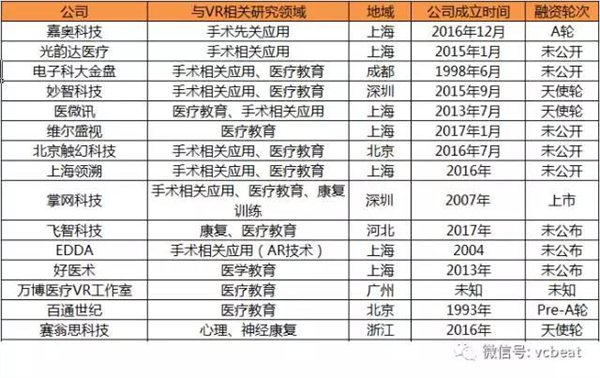
Image source: Photographed network
Since the VR/AR fire in 2016, this year's limelight has already been surpassed by artificial intelligence and robots.
This year, the VR industry seems to be much more calm, no longer to speculate on the concept, but to go deep into the industry.
In the medical field, VR/AR technology has also been accepted by the industry and applied to areas such as rehabilitation training, stress relief and surgery.
In October 2017, ABI Research released a research report that states that the development of medical VR is driven by a variety of stakeholders, including medical staff, hospitals, schools, and medical technology companies. ABI Research predicts that the market value of the medical VR industry will reach $8.9 million this year. In 2022, this figure will reach $285 million.
“Compared with conventional medical care, VR medical treatment does not require strict treatment regulations and is very popular in the consumer field. VR applications such as smoking cessation, sleep management, stress relief, and improved memory for the elderly are used by more and more consumers. "ABI industry research analyst Khin Sandi Lynn said.
The report also points to four main areas of application for medical and healthcare VR: treatment, training, surgery-related applications, and medical research.
Treatment is currently the most common medical application for VR, and conditions such as insomnia and smoking cessation are also included.
In China, medical VR\AR is getting better and better in preoperative planning, surgical navigation, and medical education. VR is not dead, but it is matching clinical.

VR+ surgery related applications
In China, VR technology in surgery-related applications are mainly preoperative planning and surgical navigation.
Preoperative planning
Many doctors use two-dimensional CT images to diagnose the condition, so that they can only see a flat image, but not all parts of the body, which will increase the difficulty of accurately determining the condition.
VR technology can observe various parts of the three-dimensional body, and even observe the minute details of each part and the internal structure of the part.
Some products can use the operating pen to perform a comprehensive analysis of the body parts in six dimensions, achieving a series of functions such as zooming, panning, rotating, cutting, and coloring.
Taking illusion technology as an example, the illusion VR display system is a real-time interactive 3D imaging system. It can reconstruct the model by CT/MRI scanning human organ tissue, and can also make human body models or artificial models imported into other standards. For medical teaching.
Unlike technologies such as Vive and Oculus, doctors don't need to wear VR helmets during diagnosis or surgery. They only need to wear thin 3D glasses. With our display screen, 3D images of surgical organs can be observed. Observing organs while not being out of reality, can communicate and communicate with patients in real time.
Surgical navigation

As we all know, the operation of spinal surgery and brain surgery is very difficult. Taking pedicle screw technique as an example, doctors put several screws into the pedicle of the spine to treat spinal diseases and inject therapeutics.
This sounds simple, and it is very difficult to actually operate, because the spine is the most dense part of the human blood vessels and nerves. Deviation during nail placement can have serious consequences. In this case, the need for a spinal surgery navigation system is very high.
The navigation system allows the doctor to clearly understand the current operating status and the next positioning, greatly reducing operational and positioning errors. Just like the image shown below, you can also see the image displayed by VR navigation on the original image.
In this field, Shenzhen Palm Network Technology is very representative. In October 2017, Palm Network Technology and the Third Affiliated Hospital of Southern University of Science and Technology jointly established the VR Medical Joint Laboratory to jointly develop the industry's first-class VR medical products.
Liu Cundong, director of the Department of Urology, the Third Affiliated Hospital of Southern Medical University, said: "Virtual reality technology allows doctors to see the human body. Accurate medical treatment is no longer just based on experience and intuition. The risk of surgery is greatly reduced. In the future, combined with robotic equipment and technology may be implemented for clinical surgery. Subversive changes."
Director Liu Cundong's point of view is a development trend of future science and technology medical care. VR technology combined with surgical robots allows surgical robots to be not only minimally invasive but also precise when performing surgery. According to the arterial network, there are related companies that are promoting this cooperation.
In addition, in September this year, the medical VR company Jiaao Technology, which is engaged in research in this field, announced that it has won the volcanic stone capital investment, Songhe Capital and the investment of tens of millions of RMB A round of financing.
The EDDA technology that has been reported by the arterial network has also achieved surgical navigation using AR technology.
EDDA's original AI+QMR holographic full-quantity reality virtual can be used to perform three-dimensional anatomy of various personalized human organs and various tissues and lesions from various angles through gestures and voice commands, and to perform immersive operations consistent with clinical actual needs; More importantly, the three-dimensional volume, distance, angle, and vessel diameter can be quantitatively analyzed in real time, so that preoperative full quantitative three-dimensional accurate assessment, virtual surgery simulation and surgical risk assessment can be performed.
From the current development point of view, preoperative planning, surgical navigation is the most mature application of VR\AR technology in medical treatment, and it is also the most promising application.
VR+ medical education
The ultimate goal of medical education is clinical operation, but the traditional graphic teaching materials lack the characteristics of interaction and stereo, which is difficult to give the learners substantial and effective guidance, especially the high value of resources but rare opportunities such as physical anatomy and surgery. It is the advantage of cutting VR.
The virtual reality system can provide students with better medical training that cannot be provided in a classroom environment.
With the help of three-dimensional modeling, positioning ranging, five-dimensional coordinates (three-dimensional space + parallel universe), VR has great advantages in analog organ anatomy and virtual surgery.
Specifically, there are three forms of VR application in medical education.
Surgery panoramic live broadcast
On May 30 last year, the world's first VR live broadcast of 3D laparoscopic surgery was performed at Ruijin Hospital, Shanghai Jiaotong University School of Medicine: Zheng Minhua, director of the Department of Gastrointestinal Surgery and Shanghai Minimally Invasive Surgery Clinical Medicine, an 82-year-old female patient. Perform 3D laparoscopic radical surgery for right colon cancer.
The technology and equipment required for VR live broadcast are not complicated. Six special panoramic cameras are set up above the operating table to ensure that the first scene is recorded 360 degrees, and passed to the outside of the operating room for medical trainees to "close-range" observation experts. Every detail during surgery.
The live broadcast attracted hundreds of students from across the country to watch the medical show together in a classroom outside the operating room.
There are many students who have first come into contact with VR equipment, but they only need three or five minutes to be proficient. Wearing a VR head-mounted device that can be embedded in the mobile phone, the students can select the live broadcast angle and the picture by turning the head up and down and left and right.
Good medicine is a company that teaches medical education. Its "Good Medical Skills" has a large collection of medical practice videos. Doctors learn to improve their skills by watching other people's surgery. A good doctor founded in 2013 started the VR trial in 2016.
In addition to VR instructional videos, there are other traditional medical lectures. "Users can watch it for a single fee. The fee is between 20-100 yuan. The registered VIP member price is 5800 yuan a year. You can watch all the courses and participate in our offline forum of 40 games per year."
Surgical learning
Taking medical micro-information as an example, Medical Micro-Technology launched a medical +VR online surgical learning tool, Surgeek, which also included 3D interactive simulations, and also entered a 3D interactive simulation. The game is used to simulate the operation of the surgery.
The operation simulation is divided into teaching and assessment mode. In the teaching, the virtual operation can be performed according to the dubbing. After the study, you can enter the assessment mode to review your mastery. The assessment adopts the scoring system, and the score can be converted into points to unlock. Higher-order surgery (the smallest unit of surgery type), of course, if the points are not enough, you can pay for it.
In 2016, Medical Micro-Technology also received tens of millions of financing from the company.
EDDA Technology also cooperated with Tsinghua University to build a “Smart Reality Virtual Clinical Teaching Centerâ€.
In this center, doctors can directly view the anatomical details of the patient's real human body structure in a virtual space of augmented reality (AR) through special facilities, and perform real-time stereo geometry analysis of organs and lesions through gestures and voice operations. Accurately measure the location, volume, diameter, distance and other parameters of the target structure, as well as virtual anatomy, simulated surgical resection, surgical design and surgical risk assessment.
Acupuncture teaching
There are also VR for acupuncture teaching. For example, the acupuncture VR teaching software launched by Baitong Century - virtual human acupuncture teaching platform.
This software consists of two parts: the whole and the part: the whole module contains the acupuncture points of the human body and the composition of 14 meridians and all meridians containing the inner body of the two veins. The partial module divides the human body into the head and neck. The chest, arm, abdominal cavity, knee and foot are five parts.
The function information of all the acupuncture points in each part is introduced in detail in the partial module, and the acupuncture practice can be performed in the local module-simulating acupuncture process.
VR+ adjuvant therapy
In this field Switzerland's MindMaze company is doing very well. Rehabilitation after a stroke often takes a long time, and in most cases the rehabilitation is not ideal.
In May 2017, MindMaze announced that the company's MindMaze Pro VR treatment platform has been approved by the US Food and Drug Administration (FDA) to enter the US market, providing treatment options for stroke rehabilitation patients in the United States, mainly rehabilitation of upper limb nerves.
The system consists of hardware and software, and the hardware system mainly includes a depth camera and a display that can capture motion. The software content is an interactive exercise tailored based on the principles of upper limb rehabilitation and standardized neurological rehabilitation. Patients can rehabilitate damaged nerves through scientific practice.
MindMotion Pro was launched in Europe in 2013 and has completed clinical trials of 261 patients so far.
VR+ detoxification aid
In early 2017, a "VR Detoxification System" began to be used in Zhejiang's drug rehabilitation centers. The system is mainly aimed at the abuse of ice poisoning. The short film of the live-action shooting is built in. The drug addicts should receive 6 VR treatments on a regular basis. The treatment includes three short films of rehabilitating scene assessment drug addiction, aversion treatment and regression therapy.
The clinical clinical data of the system showed that more than 60 drug users had a 75% reduction in drug craving after 6 days of virtual reality system treatment; while at the same time, the control group who did not use VR treatment only 3% reduced the hunger for drugs.
In addition to these applications, VR can also be used in psychological and mental interventions, physical therapy rehabilitation, senile dementia, pain management, post-traumatic stress disorder (PTSD), concussion assessment, training midwifery women, and more. However, these applications are still in the initial stage of research, and there is still a long way to go from commercial applications. We will not consider them for the time being.
VR+ medical development dilemma
VR+Medical has so many applications, but why is there only one financing information for medical VR this year? In September 2017, Jiaao Technology announced that it has won the volcanic stone capital investment, Songhe Capital and the investment of tens of millions of RMB A round of financing.
Compared with artificial intelligence, the combination of VR and medical care is relatively poor. So where is the development dilemma?
Although VR+ medical education will have a paying party, the market size is not big, and most of the video content is the surgical panoramic video and the primary human body model science. The user will have dizziness after watching for a long time, so the paid users are limited. .
In addition, the use of VR for surgical simulation training allows doctors to clearly see and manipulate human tissue such as blood vessels and organs, but how the trainer obtains feedback on force. It is very difficult to make the force feedback and the actual surgical feedback as consistent as possible. This requires repeated communication and debugging by engineers and doctors.
In addition to the lack of maturity in the product, there is another problem that is difficult to realize.
To be a project, to open a company is different from scientific research, profit is the most important purpose, but there is still no particularly successful case of how to make money. Now you can see the pre-operative planning, surgical navigation and medical education.
How to realize medical + VR commercialization?
Medical care is a traditional and rigorous industry. Its fault-tolerant mentality is much worse than other industries. Therefore, the first step for entrepreneurs to achieve commercialization is to solidify their products, especially those involving surgery. . In the research and development, it can also learn from other industries, such as how the surgical robot solves the problem of force feedback.
In the process of clinical use, companies should ask professionals to summarize the assessment in order to get endorsement by experts. If the financing of the startup is not smooth, you can try to obtain funding support for the research project, but this can only solve the urgent need, the most important thing is to do a risk assessment.
The last and most important thing is to find the payer. Only with continuous blood transfusion can the company last. In addition to the hospital, the paying party can also cooperate with the enterprise. For example, in cooperation with the robot industry, although the surgical robot is minimally invasive, the navigation problem needs to be combined with VR or AR technology, and the entrepreneur can try to contact.
At the same time, the state should also issue corresponding policy support. Wen Qilei, a researcher at the Institute of Virtual Reality and Artificial Intelligence Industry of Tsinghua University, pointed out that the country needs to introduce encouraging policies to promote joint development of products between enterprises and hospitals, and accelerate the VR+ medical soil. In order to solve the problem of hospital payment and bidding purchase, it can promote the joint research and development of enterprises and hospitals, and also enable hospital research institutions to promote the development of medical + VR.
This part of BBQ Tools Set usually is packing with tired card, head card,buster card for showing the item clearly. And the single item also will be packed with color box .In this part we will show some item for special use such as slotted turner with jag for cutting side cooking,a large area of turner for cooking massive meat and so on.Certainly ,customized is accepted that you can print your logo on it or manufacture your design. Our bbq tools of handle material have many different choice like hardwood ,beech,PP,PVC, bakelite , metal etc..
Grill Tools Set,Grill Set,Grill Tools,Grill Accessories,BBQ Fire Grill,Non-Stick Bbq Grill,BBQ Chimney
MEO DEMO CO., LTD. , https://www.meokitchentools.com